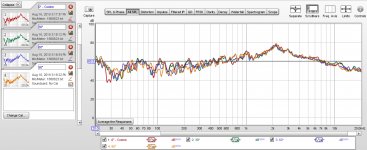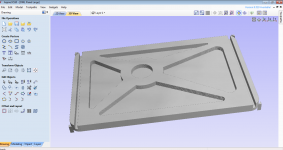For an explanation about some aspects of DML’s by a physicist, search YouTube for:
‘Tectonic Plates in Reverberant Spaces’
It is pertinent to what is being discussed at the moment.
‘Tectonic Plates in Reverberant Spaces’
It is pertinent to what is being discussed at the moment.
Hi all,
It's been a while but I've finally managed to finish my first test pair. They are small'ish carved XPS panels (350mm X 560mm) suspended within a hardwood frame, polyfill and cork backed because I want them to be wall mounted.
They sound very good paired with a small subwoofer but they did lose a tiny bit of magic when I closed up the back.
Attached is just a few quick pics and a REW measurement.
........on to the next panels 😀
JMatt,
Those look great and the REW plot looks good too.
Can you tell us about the carving you did? Did you try the XPS panels without carving before you machined them? What did you hope to achieve by machining them?
Eric
Why do you think that?
A speaker cant mechanically change by itself from bipolar to dipolar. So its either bipolar or its not.
Put two drivers in a box on opposite sides. In phase, the speaker is bipolar. Out of phase, the speaker is dipolar. Play two different frequencies. One frequency in phase on both drivers. The other, out of phase. Is the speaker bipolar or dipolar?
FFS. The DML is chaotic. The panel is vibrating such that the radiation is in phase at one spot, out of phase at another, in phase at another, out of phase at another, almost ad infinitum, all over the surface. It is most definitely not a big piston.A speaker cant mechanically change by itself from bipolar to dipolar. So its either bipolar or its not.
Put two drivers in a box on opposite sides. In phase, the speaker is bipolar. Out of phase, the speaker is dipolar. Play two different frequencies. One frequency in phase on both drivers. The other, out of phase. Is the speaker bipolar or dipolar?
What is this double speak? If both speakers are in phase its bipolar if one speaker is out of phase its dipole.
FFS. The DML is chaotic. The panel is vibrating such that the radiation is in phase at one spot, out of phase at another, in phase at another, out of phase at another, almost ad infinitum, all over the surface. It is most definitely not a big piston.
So once again I am asking you is it Bipolar, dipole, or other aka as you call it chaotic? I need a definite answer.
Last edited:
I gave you the answer.So once again I am asking you is it Bipolar, dipole, or other aka as you call it chaotic? I need a definite answer.
Not if it's neither.A speaker cant mechanically change by itself from bipolar to dipolar. So its either bipolar or its not.
Basically what he is saying is the radiation from the DML is not coherent, in a phase sense. The chaotic nature of the surface vibration does not give rise to a coherent wavefront.For an explanation about some aspects of DML’s by a physicist, search YouTube for:
‘Tectonic Plates in Reverberant Spaces’
It is pertinent to what is being discussed at the moment.
I gave you the answer. Not if it's neither.
Ok so you're answer is neither and or aka Chaotic. Got it.
So lets get back to this post where you said and quote>Tagis, you're correct. DMLBES is not. The DML is chaotic, it isn't phase coherent so it is not a bipole in the acoustic sense.
Tagis said they are dipoles , you said they are neither, so why is tagis right and I am wrong. Aint we both wrong according to your theory?
Last edited:
Jethro Tull released an album called Thick as a brick. Its either that or you just like to argue for the sake of it. Over and out.Ok so you're answer is neither and or aka Chaotic. Got it.
So lets get back to this post where you said and quote>Tagis, you're correct. DMLBES is not. The DML is chaotic, it isn't phase coherent so it is not a bipole in the acoustic sense.
Tagis said they are dipoles , you said they are neither, so why is tagis right and I am wrong. Aint we both wrong according to your theory?
Jethro Tull released an album called Thick as a brick. Its either that or you just like to argue for the sake of it. Over and out.
I am just proving a point that you are a troll. LMAO
Hi,
I am getting confuse over the terms used describing DML speakers being bipolar?
If one says the speaker is bipolar then both the front surface and back surface have to be 180 degrees in or out of phase. How does the audio exciter accomplish this if the exciter is moving forward the front surface is generating a compression wave and the back surface is generating a reification wave is this not a dipole like a magnapan or electrostatic speaker? How do you move the front and back surface in opposite direction at the same time with one exciter?
I don't know. But here's my REW measurements while rotating the speaker 90 degrees. There's no cancellation on the 90 degree axis. However, there should be cancellation because I have tall thin panels that move in pistonic motion.
Attachments
Exactly......
Try the simplest DML set up. Make a stereo pair of DML’s with two plywood sheets of an appropriate size and fix one exciter to each near the middle but off centre. Hang these by whatever means (wire or string) away from walls and ceilings as a speaker pair. Play music through them and then listen to them at a conventional position, then walk up to and between the panels and behind them and around them and listen to what you hear as you go.
You’ll realise that neither Dipole nor Bipole adequately describes the sound field emitted........
Try the simplest DML set up. Make a stereo pair of DML’s with two plywood sheets of an appropriate size and fix one exciter to each near the middle but off centre. Hang these by whatever means (wire or string) away from walls and ceilings as a speaker pair. Play music through them and then listen to them at a conventional position, then walk up to and between the panels and behind them and around them and listen to what you hear as you go.
You’ll realise that neither Dipole nor Bipole adequately describes the sound field emitted........
I am no expert in physics, but, here's my take...
The exciter is like the initiator of the waves, that is amplified and transmitted by the panel.
Think of it as a rock thrown in a pond, it creates ripples.. just like sound waves.
Freeze that moment and you see the phase and out of phase signal.

BUT...
the signal moves away along the board in time, just like the ripples in the pond, so what was in phase, is now out of phase a millisecond later (or ns?)
Our ears cannot detect this fast change in phase, so, it sounds all the same to us.
I guess it's a simplistic view of how I see (hear) what's happening in this case...
So, I guess no one is truly right in this case.
It is not a dipole nor a bipole because of the phase switching happening in fractions of time.
But it is not chaotic either... it is not a mambo jambo of spikes all over the place on the board.
Hope I didn't ruffle too many feathers here with how I see this thing, however simplistic this might be.
😀
The exciter is like the initiator of the waves, that is amplified and transmitted by the panel.
Think of it as a rock thrown in a pond, it creates ripples.. just like sound waves.
Freeze that moment and you see the phase and out of phase signal.

BUT...
the signal moves away along the board in time, just like the ripples in the pond, so what was in phase, is now out of phase a millisecond later (or ns?)
Our ears cannot detect this fast change in phase, so, it sounds all the same to us.
I guess it's a simplistic view of how I see (hear) what's happening in this case...
So, I guess no one is truly right in this case.
It is not a dipole nor a bipole because of the phase switching happening in fractions of time.
But it is not chaotic either... it is not a mambo jambo of spikes all over the place on the board.
Hope I didn't ruffle too many feathers here with how I see this thing, however simplistic this might be.
😀
I am no expert in physics, but, here's my take...
The exciter is like the initiator of the waves, that is amplified and transmitted by the panel.
Think of it as a rock thrown in a pond, it creates ripples.. just like sound waves.
Freeze that moment and you see the phase and out of phase signal.

BUT...
the signal moves away along the board in time, just like the ripples in the pond, so what was in phase, is now out of phase a millisecond later (or ns?)
Our ears cannot detect this fast change in phase, so, it sounds all the same to us.
I guess it's a simplistic view of how I see (hear) what's happening in this case...
So, I guess no one is truly right in this case.
It is not a dipole nor a bipole because of the phase switching happening in fractions of time.
But it is not chaotic either... it is not a mambo jambo of spikes all over the place on the board.
Hope I didn't ruffle too many feathers here with how I see this thing, however simplistic this might be.
😀
Now this is a good post. I agree with the pond analogy theory, it is pretty simplistic.
Change in phase. Variables of phases from 1 degree to 180 degrees out of phase. My theory is less degree of phase the more it will sound like bipolar even though its not a true bipolar due to a slight differences in phase. So technically it could be dipole.
Last edited:
JMatt,
Those look great and the REW plot looks good too.
Can you tell us about the carving you did? Did you try the XPS panels without carving before you machined them? What did you hope to achieve by machining them?
Eric
Thank you Veleric, the attached photo is what I ended up carving on my cnc. It might just be a placebo but to me the carving improved the overall sound on smaller panels a bit. On my next build I'll do a lot more measurements to see if there's really a difference.
Attachments
At two different frequencies, the drivers of a speaker can be in phase and out of phase at the same time. It's a contradiction to say a speaker must be either bipole or dipole, and then go on to say that the same speaker is both.What is this double speak? If both speakers are in phase its bipolar if one speaker is out of phase its dipole.
I don't use doublespeak.
- Home
- Loudspeakers
- Full Range
- A Study of DMLs as a Full Range Speaker

